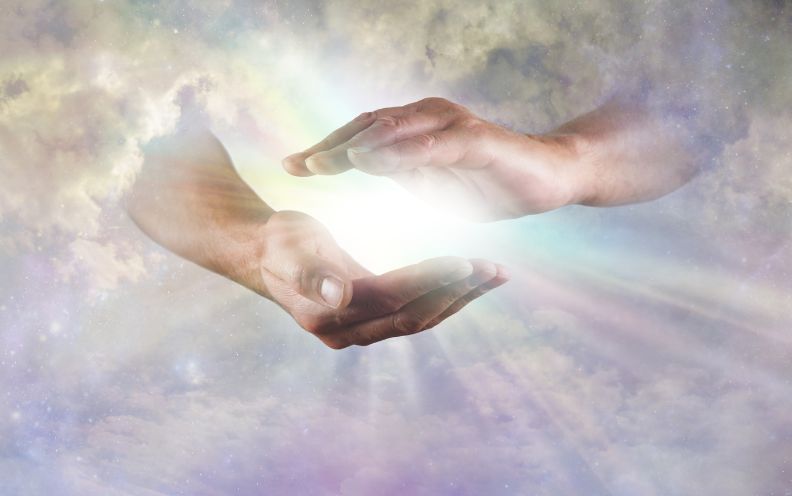Your Body Is Listening
Your Body is Listening is an invaluable companion for those of us seeking simple and powerful ways to enhance our daily lives and natural rhythms.

Founder of Wellbeing Winnie, Author of 'You Body Is Listening'
Masculine and Feminine Energy – At the core of our existence lies an intricate tapestry of energy, an ever-flowing current that courses through every one of us. This energy is not confined to the physical realm but extends far beyond, influencing our thoughts, emotions, and the very fabric of our reality.
We are all energy beings, vibrating at specific frequencies that shape and mould the physical matter around us. In this vibrational dance, we weave the tapestry of our lives, manifesting our desires and shaping our experiences. The tangible world we consciously perceive is but a reflection of this energy, a manifestation of the limitless possibilities that lie within us.
Duality, a defining aspect of our three-dimensional world, plays a crucial role in this dance of energy. It presents us with a spectrum of experiences, from joy to sorrow, love to fear, light to darkness. Through these contrasts, we learn and grow, expanding our consciousness and deepening our understanding of the interconnectedness of all things.
As we navigate this three-dimensional realm, it is essential to remember that we are not limited by it. We possess the power to transcend the boundaries of duality and access the vastness of our energetic potential. By embracing our true nature as energy beings, we open ourselves to a world of limitless possibilities and profound transformation.
Feminine Energy - is (but not in all cases) an energy of 'being' and is more feeling and thought-based. understanding the ebb and flow of the energy. thriving in the processing, deliberating, reaching mental achievement before any physical activity is applied
Masculine Energy - is (but not in all cases) an energy of 'doing' and action-based, performing and achieving, feeling good from seeing results, using physical ability to drive forward, being protective and ensuring time and energy is used efficiently.
The universe , it is said, is a combination of two energies the masculine and the feminine
Using masculinity or femininity in terms of energy. Typically the male gender is more masculine in energy, and the female is more feminine in energy. However, this isn’t always the case and a female can identify with the masculine energy, just as a male can relate to a more feminine approach. The universe, as many have contemplated, is believed to be a harmonious blend of two fundamental energies: the masculine and the feminine. These energies are not limited to gender; rather, they represent different qualities and attributes that exist within all individuals, regardless of their physical sex.
Traditionally, masculine energy is associated with qualities such as assertiveness, strength, and rationality. It is the energy of action, ambition, and drive. The feminine energy, on the other hand, is associated with qualities such as receptivity, intuition, and creativity. It is the energy of nurturing, compassion, and connection.
While these energies are often associated with specific genders, it is important to remember that they are not exclusive to men or women. Anyone can embody both masculine and feminine qualities, regardless of their physical form. It is the balance and integration of these energies within ourselves that leads to harmony and wholeness.
We can also summarise from philosophers that the male and feminine balance is less about people and more about behaviour or duality of all things. For example: when they speak about the heat and fire temperament of the sun and the secretive, cold softness of the moon. Or the leader is in the form of consciousness and the follower the form of the subconsciousness.
Neville Goddard: “Feeling is the Secret”
Although the subconscious faithfully serves man, it must not be inferred that the relation is that of a servant to a master as was anciently conceived. The ancient prophets called it the slave and servant of man. St. Paul personified it as a “woman” and said: “The woman should be subject to man in everything” [Ephesians 5:24; also, 1Corinthians 14:34, Ephesians 5:22, Colossians 3:18, 1Peter 3:1]. The subconscious does serve man and faithfully gives form to his feelings. However, the subconscious has a distinct distaste for compulsion and responds to persuasion rather than to command; consequently, it resembles the beloved wife more than the servant.
The conscious (objective) or male aspect truly is the head and dominates the subconscious (subjective) or female aspect. However, this leadership is not that of the tyrant, but of the lover.
This more expansive view demonstrates that the masculine and feminine energies can be seen as complementary forces that work together to create the dynamic interplay of the universe. The masculine energy provides the spark of creation, while the feminine energy nurtures and sustains it. Together, they weave the intricate tapestry of existence.
Embracing both our masculine and feminine sides allows us to live more authentically and harmoniously. By integrating these energies within ourselves, we can access a greater sense of balance, creativity, and fulfilment. It is in this union of opposites that we find the true essence of our being.
An individual who embodies masculine energy is naturally drawn to a partner who predominantly embodies feminine energy. This is because they are attracted to each other’s complementary qualities.
Generally, this is not a problem since most people tend to have a dominant energy. However, issues arise when someone is overly active in one particular energy. This imbalance is usually the result of subconscious beliefs, past traumas, or innate coping strategies.

These imbalances manifest in the following ways:
Overactive masculine personality traits may include (but not always all of these at the same time or with the same person):
- Maintains a consistent routine of physical activity and experiences a sense of remorse or inadequacy when required to remain stationary.
- Motivated by ego and the intense need to prove their value, individuals centre their happiness on external validation, seeking approval and recognition from others.
- Searches for maternal support and relies heavily on female archetypes
- Assumes full responsibility or none whatsoever.
- Easily angered, they may experience emotional outbursts or complete detachment.
- Are often overbearing and overprotective and need to be in full control
- Cultivate a sense of accomplishment through their acquisition and possession.
Extremes include:
- Aggressiveness
- Narcissism
- Possessiveness
- Emotionally and physically abusive
It is crucial to recognize that an individual may exhibit excessive masculine energy only when they perceive a threat or have undergone prolonged periods of stress.
The intensity of this excessive energy can vary, leading to individuals who either exhibit more dominant masculine traits or display less severe and noticeable characteristics.
When the traits are less obvious, spouses, friends, and family can be unaware of the harm being caused until the situation becomes severe. In such cases, those affected have often already learned to adapt to the individual’s behaviour. This can be seen when a child adopts survival behaviours from an overbearing or overprotective parent, for instance.
The overactive feminine energy traits include:
- Unintentional actions or fixed belief systems
- Heightened sensitivity to situations and the words spoken by others (this can also be a masculine energetic trait)
- The pervasive sense of disinterest and emotional detachment known as apathy
- Procrastination, which can lead to a lack of motivation, energy, and enthusiasm. Furthermore, it can also involve a profound sense of indifference and a lessened capacity to experience emotions.
- Easily influenced and manipulated, they consistently allow themselves to be taken advantage of.
- Prioritises the needs of others, often at the expense of their own, demonstrating a high level of responsibility and selflessness.
- The lack of clearly established boundaries may subject individuals to undesirable or uncomfortable circumstances.
- The inability to say no can be both a blessing and a curse. On the one hand, it can make you a more agreeable and well-liked person. However, on the other hand, it can also lead to burnout and resentment.
- Fear of criticism and facing the feeling of inadequacy due to concerns about upsetting others and the opinions they hold.
- Struggles with self-worth and a diminished sense of personal value
- They may experience isolation in their lives, as they find it challenging to readily accept assistance from others. (also can be a masculine trait)
- Emotionally needy individuals display an intense craving for affection and support from others. Or may never be able to ask for help adopting masculine energy that makes them super independent.
The feminine energy, similar to its masculine counterpart, exists on a spectrum. It may not always be immediately apparent, and individuals may only recognize their feminine characteristics when they reach a point of exhaustion.
As the universal energy strives to maintain equilibrium, a continual dance takes place. This dynamic interplay closely resembles the Chinese philosophical concept of yin (feminine energy) and yang (masculine energy).
At extremes, we can observe masculine energy reaching a critical point, leading to depression, isolation, and an inability to find motivation.
Similarly, when the sensitive, feminine energy is undervalued, it may reach a breaking point and become highly aggressive.
This energy imbalance, which can range in severity, often stems from adverse childhood experiences such as trauma, neglect, or abuse. It can also result from unhealthy relationships in adulthood, disillusionment with life, or engaging in detrimental behaviours such as substance abuse or compulsive gambling.
While recurring themes in our lives are often viewed as problematic, they provide valuable insights into our subconscious beliefs and the patterns of behaviour that we have come to adopt. By examining these recurring themes, we can gain a deeper understanding of ourselves and the underlying factors that influence our actions and choices.
For example, if you find yourself constantly struggling with relationships, it may be a sign that you have a subconscious belief heavy in feminine traits such as the understanding that you are unworthy of love or that you will inevitably be abandoned. This belief may have originated from childhood experiences, such as having parents who were emotionally unavailable or who divorced when you were young.
By recognizing and challenging these subconscious beliefs coupled with the masculine and feminine energy balance, you can begin to shift your perspective and create more positive and fulfilling relationships. This process involves self-awareness, self-compassion, and a willingness to change the patterns that are no longer serving you.